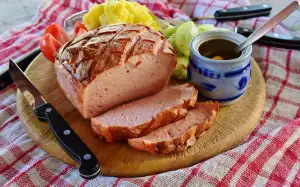Delicious Orecchiette Recipes: Discover the Charm of Pasta Shaped Like Small Ears

- History and Origin of Orecchiette
- Ingredients Required for Orecchiette
- Step-by-Step Instructions to Make Orecchiette from Scratch
- Traditional Orecchiette Recipes from Italy
- Variations and Creative Ways to Serve Orecchiette
- Health Benefits of Orecchiette
- Tips and Tricks for Perfectly Cooked Orecchiette
Orecchiette, meaning "little ears" in Italian, is a unique and delightful pasta shape that has captured the hearts and palates of food enthusiasts around the world. This small, round pasta with a concave shape resembles tiny ears, making it not only visually appealing but also perfect for holding sauces and ingredients. Orecchiette's charming appearance and versatility make it a popular choice for countless delicious recipes. Whether you're a pasta lover or simply curious about exploring new culinary experiences, orecchiette is sure to captivate your taste buds and leave you craving for more.
History and Origin of Orecchiette
Orecchiette, meaning "little ears" in Italian, is a traditional pasta shape that originated in the southern region of Puglia. Its history can be traced back to the 12th century when Arab traders introduced durum wheat to the area. The unique shape of orecchiette is said to have been inspired by the earlobes of local women who made pasta by hand. This humble yet versatile pasta has since become a beloved staple in Italian cuisine and is now enjoyed worldwide.
Ingredients Required for Orecchiette
To make orecchiette from scratch, you will need just a few simple ingredients. The main ingredient is semolina flour, which gives the pasta its distinct texture and flavor. You will also need water to bind the dough together. Some recipes may call for the addition of all-purpose flour or eggs, but traditional orecchiette is made with just semolina and water. Additionally, a pinch of salt can be added to enhance the taste of the pasta. With these basic ingredients, you can create your own delicious orecchiette at home.
Step-by-Step Instructions to Make Orecchiette from Scratch
1. In a large mixing bowl, combine 2 cups of semolina flour and a pinch of salt.
2. Create a well in the center and gradually add ¾ cup of warm water.
3. Using your hands, mix the flour and water until it forms a rough dough.
4. Knead the dough on a floured surface for about 10 minutes until it becomes smooth and elastic.
5. Divide the dough into small portions and roll each portion into long ropes, about ¼ inch thick.
6. Cut the ropes into small pieces, approximately ½ inch in length.
7. Take each piece and press it against your thumb or the back of a fork, creating an indentation in the center.
8. Gently push the dough away from you, causing it to curl up and form the characteristic ear shape.
9. Place the shaped orecchiette on a lightly floured baking sheet to prevent sticking.
10. Repeat this process with the remaining dough until all orecchiette are formed.
11. Bring a large pot of salted water to boil and add the orecchiette.
12. Cook for about 8-10 minutes or until al dente, stirring occasionally to prevent sticking.
13. Drain the cooked orecchiette and toss with your favorite sauce or ingredients.
Enjoy homemade orecchiette that's tender, chewy, and full of flavor!
Traditional Orecchiette Recipes from Italy
Italy is known for its rich culinary heritage, and orecchiette is no exception. Here are a few traditional recipes that showcase the versatility and deliciousness of this pasta:
1. Orecchiette with Broccoli Rabe: This classic dish combines the slightly bitter taste of broccoli rabe with garlic, chili flakes, and olive oil. Toss in cooked orecchiette and sprinkle with grated pecorino cheese for a simple yet flavorful meal.
2. Orecchiette with Sausage and Tomato Sauce: In this hearty recipe, brown Italian sausage in a pan, then add tomato sauce and simmer until flavors meld together. Serve over cooked orecchiette and garnish with fresh basil leaves.
3. Orecchiette with Pesto Genovese: For a taste of Genoa, toss freshly made pesto sauce (made from basil leaves, pine nuts, garlic, Parmesan cheese, and olive oil) with cooked orecchiette. Top it off with some toasted pine nuts for added crunch.
4. Orecchiette alla Barese: A specialty from Bari in southern Italy, this dish features orecchiette tossed with a rich sauce made from tomatoes, anchovies, olives, capers, garlic, and olive oil. It's a burst of Mediterranean flavors on your plate.
These traditional recipes capture the essence of Italian cuisine while highlighting the unique shape of orecchiette. Give them a try to experience the true charm of this pasta!
Variations and Creative Ways to Serve Orecchiette
Orecchiette, with its unique shape and texture, lends itself well to a variety of delicious preparations. Here are some creative ways to serve this delightful pasta:
1. Orecchiette with Broccoli Rabe and Sausage: Sauté garlic and red pepper flakes in olive oil. Add cooked orecchiette, blanched broccoli rabe, and cooked sausage. Toss together and finish with grated Parmesan.
2. Orecchiette with Cherry Tomatoes and Basil: Sauté cherry tomatoes in olive oil until softened. Toss with cooked orecchiette, fresh basil leaves, salt, pepper, and a sprinkle of Parmesan.
3. Orecchiette Carbonara: Cook pancetta until crispy. In a separate bowl, whisk together eggs, grated Pecorino Romano cheese, black pepper, and a pinch of salt. Toss the cooked orecchiette with the pancetta and egg mixture for a creamy carbonara sauce.
4. Orecchiette Primavera: Sauté seasonal vegetables like bell peppers, zucchini, carrots, and peas in olive oil. Toss with cooked orecchiette and finish with a squeeze of lemon juice and chopped fresh herbs.
5. Orecchiette Alfredo: Prepare a classic Alfredo sauce by melting butter in a pan and adding minced garlic. Stir in heavy cream and grated Parmesan until smooth. Toss the sauce with cooked orecchiette for a rich and indulgent dish.
6. Orecchiette Salad: Cook orecchiette until al dente and rinse under cold water to cool it down. Mix it with diced tomatoes, cucumbers, olives, feta cheese crumbles, fresh herbs like parsley or basil, lemon juice, and olive oil for a refreshing pasta salad.
These are just a few examples of the countless ways you can enjoy orecchiette. Let your creativity flow and experiment with different ingredients and flavors to create your own unique dishes.
Health Benefits of Orecchiette
Orecchiette, the delightful pasta shaped like small ears, not only pleases our taste buds but also offers several health benefits. Made from durum wheat semolina, orecchiette is a good source of complex carbohydrates that provide sustained energy. It is low in fat and cholesterol-free, making it a heart-healthy choice. Orecchiette is also rich in dietary fiber, aiding digestion and promoting a healthy gut. Additionally, it contains essential minerals like iron and magnesium that contribute to overall well-being. So indulge in this delicious pasta guilt-free and reap its nutritional advantages!
Tips and Tricks for Perfectly Cooked Orecchiette
1. Use a large pot: Orecchiette needs enough space to cook evenly, so make sure to use a large pot with plenty of water.
2. Salt the water generously: Add a generous amount of salt to the boiling water before adding the orecchiette. This will enhance the flavor of the pasta.
3. Cook al dente: Orecchiette should be cooked until it is firm but still tender to the bite, known as "al dente." Follow the package instructions for cooking time, but start checking for doneness a minute or two before that to avoid overcooking.
4. Stir occasionally: Stir the orecchiette occasionally while cooking to prevent it from sticking together.
5. Test for doneness: To check if the orecchiette is cooked perfectly, taste a piece. It should have a slight resistance when bitten into but not be too hard or mushy.
6. Save some pasta water: Before draining the cooked orecchiette, reserve some of the pasta water. This starchy liquid can be used to adjust the consistency of sauces or loosen up dry pasta dishes.
7. Rinse only if necessary: Unlike other types of pasta, orecchiette does not need to be rinsed after cooking unless you are using it in a cold salad dish. Rinsing can remove some of its starchy coating, which helps sauces cling better.
8. Serve immediately: Orecchiette is best served immediately after cooking while it is still hot and flavorful.
By following these tips and tricks, you can ensure that your orecchiette turns out perfectly cooked every time, ready to be enjoyed with your favorite sauce or ingredients!
In conclusion, Orecchiette is a truly delightful pasta that offers a unique culinary experience. Its small ear-like shape and chewy texture make it perfect for capturing sauces and flavors. Whether you prefer traditional Italian recipes or want to explore creative variations, Orecchiette is sure to satisfy your taste buds. With its rich history, versatile nature, and health benefits, this pasta deserves a special place in your kitchen. So go ahead, embrace the delightful world of Orecchiette and let it transport you to the heart of Italy with every bite!
Published: 04. 02. 2024
Category: Recipes



